Getting to the Surface of the Moon FasterWe fully supports accelerating NASA's goal of landing humans on the surface of the Moon. We've been conducting in-depth studies on what an accelerated landing schedule would require. With the right level of commitment, urgency and resources, humans could walk on the surface by 2024.
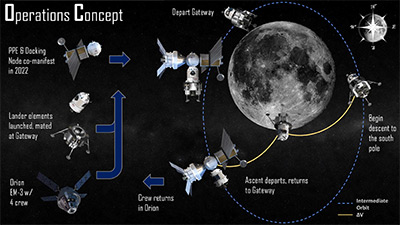
Our concept would deploy an early version of the Gateway using only its propulsion module and docking port, which puts the critical enabling elements in lunar orbit as quickly as possible. It would also design the crewed lander around proven avionics, structures and propulsion systems from Orion's crew and service modules, which are already built for human-rated lunar exploration.
The assembly of the Orion EM-1 spaceship that will go back to the Moon is nearly complete, and we are already building the EM-2 spacecraft that will take crew to the Moon. This approach delivers an earlier landing capability featuring reusable technology that also lays a foundation for a future expanded, sustainable human presence at the Moon.
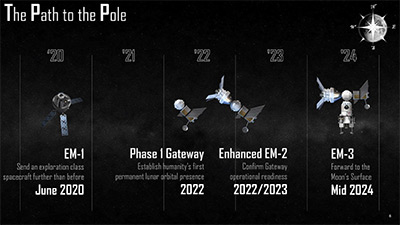
This is an aggressive but achievable schedule and could be the catalyst to help jump-start a new era of human exploration of the Moon, Mars and beyond.
Orion
NASA's Orion spacecraft is the only capsule specifically designed and built to withstand the punishing environment of deep space. We designed Orion with the technology needed for the extremes of deep space, such as life support, navigation, radiation shielding, communications and its heat shield. The next test flight of Orion, on a Space Launch System (SLS) rocket, called Exploration Mission-1, will take the uncrewed Orion beyond the Moon and back over a three-week mission.
Lunar Lander
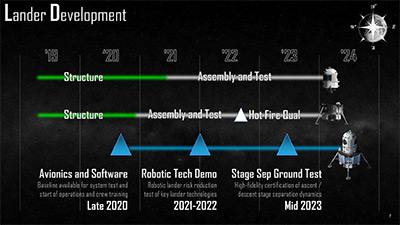
Our lunar lander concept includes a two-stage lander rather than NASA's concept of a three-stage lander with ascent and descent elements as well as a transfer vehicle. The lander design taps into four decades of Mars landing experience and Orion design and testing. The lander would include a crew module and ascent stage based on Orion technology and a larger descent element that would eliminate the need for a transfer vehicle for the astronauts.
A landed mission to the Moon is more than a recreation of the Apollo missions. This time, many of the elements would be reusable. The Gateway will allow us to stay at the Moon for months at a time and land anywhere on the surface, unlike Apollo. This includes the south pole which Pence directed NASA for its first mission. Revolutionary science can be performed at the Moon which will teach us more about the origins and formation of the Moon, Earth and our solar system, and perhaps determine if the water on the moon is accessible to be turned into rocket propellant, oxygen, and drinking water.
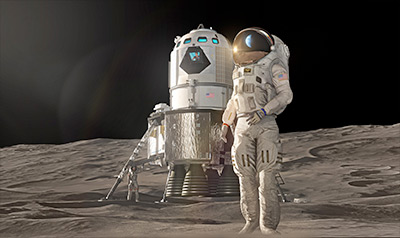
Landing astronauts on the moon within the next five years may be the primary goal, but NASA has dubbed the effort "Moon to Mars." The ultimate purpose — establish a sustainable presence at the Moon and use it not only to develop a lunar economy but also as a portal to human exploration of Mars. Targeting lunar sites with water could lead to build up of propellant production plants that could provide fuel for future deep-space missions such as Lockheed Martin's Mars Base Camp concept.
Gateway
NASA's lunar Gateway is a "space dock" that will orbit the Moon. It's where astronauts will be able to perform revolutionary science, establish a lunar commercial economy, and build and test the system elements to get us to the surface of the Moon and on to other destinations such as Mars. It's the fastest, most cost-effective way to go to the Moon and create a sustainable lunar exploration architecture.
From the Gateway, we can explore the surface of the Moon with a reusable lunar lander. Using the orbiting Gateway as a departure base makes a reusable crewed lander simpler and safer as opposed to an Apollo-style direct-to-surface mission. The lander only needs enough capability to bring a crew and some cargo to the surface, and not large pieces of infrastructure to bring people back and forth from Earth.
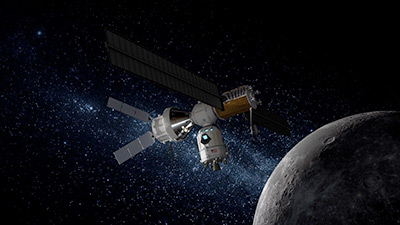
Our engineers are performing studies and creating designs to determine how Orion and future habitats will interface with the Gateway; and how the life support, radiation protection, thermal control, power, rendezvous, proximity, operations and docking, EVA airlock, and communication systems would best work in the environment of deep space.
Not only will Orion serve as the nation's first human-rated deep space exploration spacecraft, it will also play a key role in the creation of NASA's lunar orbiting Gateway by integrating and leveraging NASA's investment in Orion capability, systems and technologies. While other commercial vehicles and technologies will support the Gateway, Orion will be the workhorse behind the construction and build-up of the Gateway, allowing for a leaner Gateway in a shorter period of time.
















